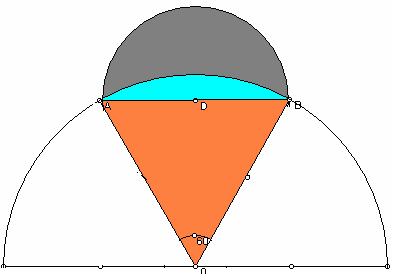Please see the attached figure:
Attachment:
 lune_over_semicircle.PNG [ 4.95 KiB | Viewed 2423 times ]
lune_over_semicircle.PNG [ 4.95 KiB | Viewed 2423 times ]
We need to find the area of the grey shade.
Area of semicircle = \(\frac{\pi*r^2}{2}\)
Area of bigger semicircle(radius=1) = \(\frac{\pi*(1)^2}{2}=\frac{\pi}{2}\)
Area of smaller semicircle(radius=1/2) = Area of Grey+ Area of Turquoise= \(\frac{\pi*(\frac{1}{2})^2}{2}=\frac{\pi}{8}\)
Area of lune = Area of grey shade = Area of smaller semicircle - Area of turquoise shade
We already know the area of the smaller semicircle. If we find the area of the turquoise shade, we will have our area of the lune.
Area of turquoise shade = Area of sector AOB(Turquoise+Orange) - Area of triangle AOB(Orange)Area of sector AOB(Turquoise+Orange) = \(\frac{\theta}{360}*\pi*r^2=\frac{\theta}{360}*\pi*(1)^2=\frac{\theta}{360}*\pi\)
\(\theta=\angle AOB=60^{\circ}\) as \(\triangle AOB\) is an equilateral triangle as AO=1(radius), BO=1(radius), AB=1(given)
Area of sector AOB(Turquoise+Orange) = \(\frac{\theta}{360}*\pi=\frac{60}{360}*\pi=\frac{\pi}{6}\).
Area of equilateral triangle AOB(Orange) = \(\frac{\sqrt{3}}{4}*r^2=\frac{\sqrt{3}}{4}*1^2=\frac{\sqrt{3}}{4}\)
Area of turquoise shade = \(\frac{\pi}{6}-\frac{\sqrt{3}}{4}\)
Area of lune = Area of smaller semicircle - Area of turquoise shade = \(\frac{\pi}{8}-(\frac{\pi}{6}-\frac{\sqrt{3}}{4})=\frac{\pi}{8}-\frac{\pi}{6}+\frac{\sqrt{3}}{4}= -\frac{\pi}{24}+\frac{\sqrt{3}}{4} = \frac{\sqrt{3}}{4} - \frac{\pi}{24}\)
Ans: "C"

 33%
(00:11)
wrong
33%
(00:11)
wrong  based on 3
sessions
based on 3
sessions

